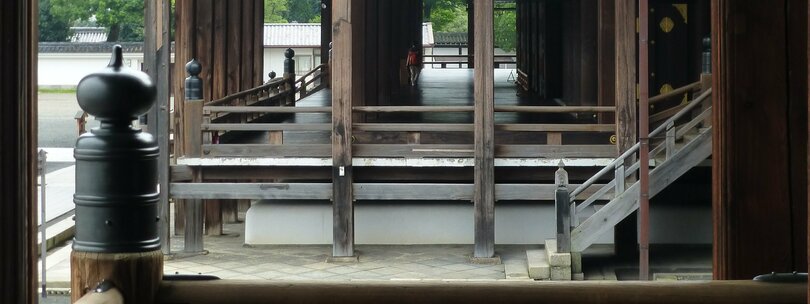I am currently reading the original Japanese version of “Tokyo Ueno Station” by Yu Miri,『JR上野駅公園口』. It’s a very nice but difficult novel, I may write more about it later. After I wrote the article on the Buddhist prayer “The Four Wisdoms”, I came across a passage in the novel that describes a Buddhist funeral and it contains a prayer used by the Jōdo Shinshū (浄土真宗, “The True Essence of the Pure Land Teaching”), known as Shinshū in Japan.
The prayer
The prayer in the book is written in archaic Japanese with old forms of kanji and grammar and uncommon words:
イジレノトキニカ娑婆ヲイデン
佛恩フカクオモヒツ、
ツ子ニ弥陀ヲ念ズベシ
娑婆永劫ノ苦ヲステ、
浄土无爲ヲ期スルコト
本師釋迦ノチカラナリ
長時ニ慈恩ヲ報ズベシ
The puzzle
I could not understand the poem, but I was curious about its meaning so I tried to find out. First of all, here is a list of the special kanji, words and constructions that I did not understand:
- 弘誓 (ぐぜい, guzei): Buddha’s universal vow
- 娑婆 (しゃば, shaba): The Sahā world, the mundane world.
- 佛: an older form of 仏 (butsu), Buddha
- 仏恩 (ブツオン、ぶっとん, button): Buddha’s blessings, the grace of Buddha’s compassion
- 弥陀 (みだ,mida): Amitabha (a celestial Buddha, the principal buddha in Pure Land Buddhism)
- 永劫 (えいごう, here pronounced yōgō): Eternity, perpetuity. 劫 (kō or gō) means kalpa.
- 浄土 (じょうど, jōdo): Lit. “pure land”, esp. the Western Pure Land paradise of Amitabha.
- 无爲: old kanji for 無為 mui: asaṃskṛta, the ‘unconditioned’, a term referring to anything that transcends conditioned (saṃskṛta) existence in the state of saṃsāra.
- 期スル (ごする,go suru): to live
- 本師 (ホンシ,honshin): Lit. “fundamental guru”, i.e. Buddha
- 釋: an older form of 釈, lit. shaka, short for Shakamuni (釈迦牟尼), the historical Buddha.
- 慈恩 (じおん_jion_): deep compassion, benevolence
- ナリ: なり (nari) is the classical version of である, “to be”.
- ベシ: べし (beshi) is the classical version of べき, “something one ought to do”. In the prayer, 念 ずべし means 念 ずるべき,”should pray”, and 報 ずべし means 報 ずるべき, “should inform”.
With these terms and the furigana in the novel, I could do a transcription in romaji:
guzei no chikara wo kafurazuba
idzure no toki ni ka shaba wo iden
button fukaku omohitsu,
tsune ni mida wo nen zubeshi
shaba yōgo no ku wo sute,
jōdo mui wo go suru koto
honshi shaka no chikara nari
jōji ni jion wo hō zubeshi
So at least I can now pronounce the prayer, and I get a rough idea of the meaning. But of course I wanted to know the details.
The origin
By searching for snippets rewritten with modern kanji and hiragana, I found that the prayer is taken from a book of hymns called Kōsō Wasan (『高僧和讃』, the “Japanese Hymns of Praise of the Virtuous Priest”), a collection of hymns written by the founder of the sect, Shinran (親鸞), who lived between 1173 and 1263 and was a remarkable person.
In particular, these are the two final hymns from “Twenty-six Hymns based on the Writings of Master Shan-tao”. Shan-tao is one of the seven masters (patriarchs) of Shinshū. He lived from 613 to 681 and is generally credited for popularizing the nembutsu as the reciting of Amida’s name (see below).
The meaning
The complete works of Shinran in English translation are available on line. The translation of the two hymns taken from there is:
Had we not received the power of the universal Vow,
When can we part from this Saha world?
Reflecting deeply on the Buddha’s benevolence,
Let us think on Amida always.
Casting off long kalpas of painful existence in this world of Saha,
We live in expectation of the Pure Land, the uncreated;
That is the power of our teacher, Shakyamuni;
Let us respond always in gratitude for his compassion and benevolence.
Pure Land Buddhism holds that there is a kind of Paradise called the Pure Land, and once one is there it is easier to reach Nirvana. Shinran advocated to trust to the power of Amitābha (Amida), as made manifest in his Universal Vow, to attain enlightenment. The main Jōdo Shinshū practice is called nembutsu, “Mindfulness of the Buddha”. The nembutsu is simply reciting the phrase Namu Amida Butsu (“I take refuge in Amitābha Buddha”, written 南無阿弥陀佛). For more information see the detailed discussion of the meaning of the hymns.
The conclusion
This is yet another example of how reading Japanese remains a difficult but very stimulating activity for me: there are lots of riddles to be solved. In translation, most of the mystery disappears. And every time I look into such a little mystery, I learn lots of new things.
- The banner picture is of the Nishi Hongan-ji (本願寺, Temple of the Primal Vow)) in Kyōto, the largest of all the Jōdo Shinshū branches.
